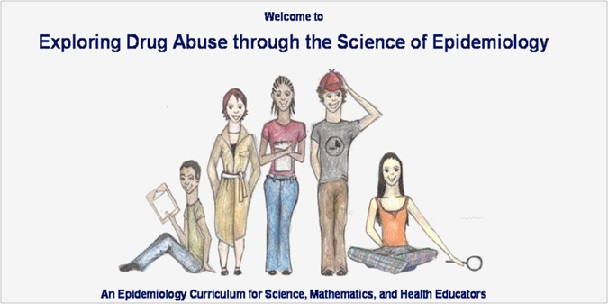
DRUG EPI
Press release: Fifty NJNER High School Students Enrolled in Montclair State University Course
 An innovative educational program in epidemiology is going on at Montclair State University (MSU). For 16 classes from September 2004 through May 2005, they are attending a MSU undergraduate course called “The Science of Public Health: Epidemiology.” The class consists of student/teacher teams from six high schools in the four school districts in the New Jersey Network for Education Renewal (NJNER); participating schools include Eastside High School, Rosa Parks High School, and the Health and Related Professions Academy (HARP) in Paterson, and the high schools in Cedar Grove, Kearny and Montclair. Each team consists of a science, mathematics, or health teacher and five students selected by the teacher.
An innovative educational program in epidemiology is going on at Montclair State University (MSU). For 16 classes from September 2004 through May 2005, they are attending a MSU undergraduate course called “The Science of Public Health: Epidemiology.” The class consists of student/teacher teams from six high schools in the four school districts in the New Jersey Network for Education Renewal (NJNER); participating schools include Eastside High School, Rosa Parks High School, and the Health and Related Professions Academy (HARP) in Paterson, and the high schools in Cedar Grove, Kearny and Montclair. Each team consists of a science, mathematics, or health teacher and five students selected by the teacher.
The class is the result of formation of an Epidemiology Education Partnership (EEP), through cooperation and support of NJNER; MSU; a Science Education Partnership Award from the National Center for Research Resources, at the National Institutes of Health; and a Science Education Drug Abuse Partnership Award from the National Institute on Drug Abuse. Taught by Dr. Mark Kaelin, from the Department of Health and Nutrition Sciences, and Dr. Wendy Huebner, a practicing occupational epidemiologist, the class meets on alternate Thursday nights from 6-9 PM at MSU.
To receive college credit, students are responsible for regular attendance and completing the course work satisfactorily. Participating teachers are responsible for attending classes with their students and mentoring their experience. In addition, teachers will identify a cross-age teaching venue and supervise their students in teaching 5-10 epidemiology lessons to middle school students. In addition, participating teachers have agreed to teach 5-10 epidemiological lessons in their regular high school classes during the 2005-2006 academic year.
The primary goal of the class is to introduce high school students and their teachers to the science of epidemiology, “…the study of the distribution and the determinants of health-related states or events and the application of these methods to the control of health problems.” (Gordis, 2004) A second goal is to pilot-test portions of a NIDA supported curriculum: Exploring Drug Abuse through the Science of Epidemiology, which is designed to explore drug abuse issues that are relevant to high school students, while simultaneously developing their understanding of the science of epidemiology.
The class content is centered around five major areas related to the science of epidemiology: 1) describing distributions of disease in populations and generating hypotheses (descriptive epidemiology); performing studies to determine factors that are associated with disease (analytic epidemiology); 3) determining causality; 4) understanding the balance between science and society in developing prevention strategies; and 5) using epidemiological methods to evaluate effectiveness of prevention strategies. Throughout the course, students will have a variety of experiences to illustrate and practice epidemiology methods - those of general interest and also as applied to the epidemiology of drug abuse.
In the first several classes, students learned about descriptive epidemiology and the three important factors that epidemiologists consider when investigating the distribution of a disease: person, place, and time. In a theoretical exercise, students have hypothesized why certain students were designated as sick and others remained healthy, and in another task, looked at descriptive epidemiological data and tried to figure out what event would have produced such data. Students have also learned about surveillance systems for detecting and monitoring disease and specifically, about how HIV / AIDS surveillance is conducted and what have been learned from this surveillance. To further their understanding of surveillance systems, students worked in groups devising ways of creating an accurate data description of drug use in the United States. Students then compared their suggestions to methods used in the National Survey on Drug Use and Health.
Students are now learning about analytic epidemiology, in which hypotheses about exposure/disease relationships are tested using rigorous scientific methods. Students are learning about the strengths and limitations of study designs that are used to test hypotheses, and examining the scientific evidence on factors that influence drug abuse. The final classes in the spring will focus on how society uses epidemiology to help make decisions about disease prevention programs and how scientific methods in epidemiology are used to evaluate public health prevention programs.
Barbara M'Gonigle, Director of the NJNER, visited the second class and told participants that they had a unique opportunity for students and teachers to learn together and she wished them well in their endeavor. Dr. Kaelin stated, "It is exciting to have the NJNER students and teachers with us in our University setting. We are delighted with the enthusiasm we see in the classroom and are looking forward to an experience that should be beneficial to all involved. We are aiming to give the students a solid background in the science of epidemiology and also its application in the epidemiology of drug abuse. More broadly, by the end of class in May 2005 we hope they will understand the role of epidemiology in our society and be able to cross-age teach some of the basic material to middle school students."
Note:
The EEP course for high school students was offered and held again in the 2005-2006 academic year.